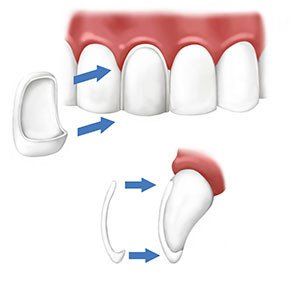There are two main types of veneers. There are conventional veneers and ultra-thin veneers. Teeth are prepared for conventional veneers by trimming off a very thin layer of enamel. This is necessary to keep the thickness of the teeth approximately the same as it was before placement of the veneers.
Ultra-thin veneers do not require as much preparation. When these veneers are ready for placement, the fronts of the teeth are roughened with an etching solution. The ultra-thin veneer bonds better with the tooth when the surface has been etched.
There are pros and cons to each type of veneer and the decision should be based on an analysis of the final result the patient wants and the process he or she is willing to experience along the way.
To trim away some of the enamel surface for conventional veneers, most dentists will numb the patient ahead of time. By contrast, ultra-thin veneers require no shaving away of the front of the tooth, so no injections are needed. If a person wants veneers, but they are anxious about dental treatment, they may favor the ultra-thin veneer.
On the other hand, conventional veneers will generally have a translucence that is more like that of natural teeth. If you look at your teeth in bright light, you will see that your teeth are not solidly white. You can see through the lower part of the tooth to some degree. Ultra-thin veneers must be made from a very durable ceramic material that will compensate for that thinness, but it does, not at this time, possess that translucence.
Conventional veneers are also thicker than ultra-thin veneers and this can add a little bulkiness to your teeth. If a person’s teeth are too small or have gaps, adding a little bulk may not be a problem. One thing to keep in mind is that once conventional veneers are placed, there is no going back to bare teeth again because of the removal of enamel. In some unique cases, the placement of ultra-thin veneers can be reversed.
When you are considering veneers, Dr. Murphy will help you consider all these points so you can get the result you want.







